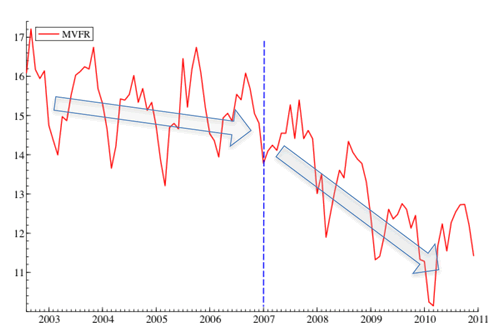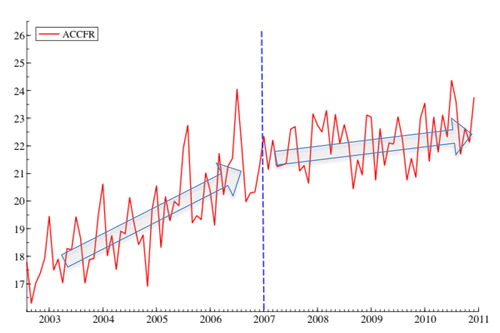New Study: Group Practice of the Transcendental Meditation and TM-Sidhi Program Reduced US Accidental Fatalities
Can group practice of meditation help reduce the rate of accidental fatalities? Surprisingly, the answer is “yes,” according to a newly published study by Institute research scientists Dr. Ken Cavanaugh and Dr. Michael Dillbeck.
The study found that over the four-year period 2007–2010, group practice of the Transcendental Meditation® and TM-Sidhi® program by participants in the Invincible America Assembly at Maharishi International University was associated with a 20.6% reduction in the rate of US motor vehicle fatalities. The rate of all other accidental deaths was also reduced by a total of 13.5% over the same period. Both reductions were in comparison to the 2002–2006 average.
The new study, published in February 2017 in the Journal of Consciousness Studies, estimates that 19,435 motor vehicle fatalities and 16,759 other accidental deaths were averted by the significantly reduced trends in accident rates.
The Invincible America Assembly is America’s largest permanent group of TM and TM-Sidhi practitioners. From 2007–2010 the size of the group was above or near 1,725 participants, the size predicted to have a positive influence on the US quality of life. This predicted threshold represents the square root of 1% of the US population.
Eighteen peer-reviewed articles have now been published validating the prediction by Maharishi Mahesh Yogi, the founder of the TM and TM-Sidhi program, that a TM-Sidhi group of this size would lead to reduced societal stress, as reflected in reduced crime, violence, and accidents, and increased positive trends in society.
The current study is the second in a series of four conducted by Dr. Dillbeck and Dr. Cavanaugh that evaluate the impact of this TM-Sidhi group on social trends. For summaries of the other three, including links to the published articles.

Figure 1. Motor vehicle fatality rate 2002–2010
The practice of the Transcendental Meditation technique is said to enable individuals to effortlessly enjoy a state of restful alertness, increased brain integration, reduced individual stress, and unfoldment of one’s inner potential. These benefits are the natural by-products of the experience during Transcendental Meditation practice of a silent, wakeful state of the mind known as “pure consciousness.”
“Maharishi explains that pure consciousness has a field-like character and is a universal field at the basis of everyone’s thought and behavior. When a sufficient number of individuals are experiencing pure consciousness during group practice of the Transcendental Meditation and TM-Sidhi program, the field of pure consciousness is enlivened in the entire population. This field effect positively influences the quality of consciousness in the individuals in society in much the same direction as that experienced by those practicing the Transcendental Meditation technique,” said lead author Dr. Kenneth Cavanaugh.
“This research tests the hypothesis that this effect of group practice results in increased alertness and reduced stress in the general population, thus contributing to reduced accident rates in society. Extensive research validates the common experience that stress can narrow awareness, inhibit vigilance and attention, and impair decision-making. Research has linked these detrimental effects of stress to increased risk of accidents,” added co-author Dr. Michael Dillbeck. For summaries of the other three, including links to the published articles, please visit the ISTPP.org home page.

Figure 2. Fatality rate for other accidents 2002–2010
In their analysis, the researchers first calculated a baseline trend for both monthly accidental fatality rates during 2002–2006, and then compared that baseline with the corresponding trend for the intervention period 2007–2010. For example, for motor vehicle fatality rates (MVFR) the authors found that the slightly declining trend during the baseline period 2002–2006 accelerated significantly beginning in January 2007 (vertical line) and continued declining during the intervention period 2007–2010 (see Figure 1). The irregular ups and downs of the fatality rate shown in the graph are largely due to seasonal fluctuations around the trend.
In the case of fatality rates for all other accidents (ACCFR), there was a highly significant shift from a rising trend in 2002–2006 to a substantially slower positive trend in 2007–2010 (see Figure 2).
The probability that the reduced trend for motor vehicle fatalities could simply be due to chance was reported to be 3.7 in 10 million million and for fatalities due to other accidents, less than 8.4 in 1 million.
The authors noted that both reduced accident trends occurred at the predicted time and in the predicted direction, and neither reduction could be predicted from baseline trends or seasonal cycles. The researchers also were able to rule out other alternative explanations. For example, the reduction in motor vehicle fatality rates could not be explained by the total number of vehicle miles traveled, weather patterns, the proportion of young drivers, improved vehicle safety features, improved roadway conditions, or alcohol consumption.


